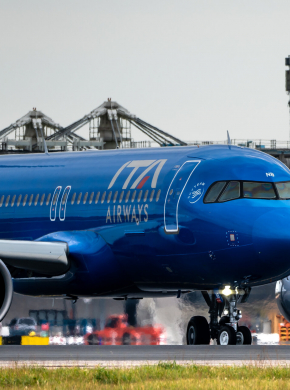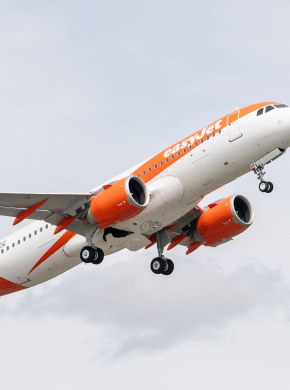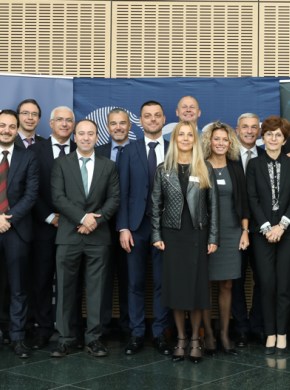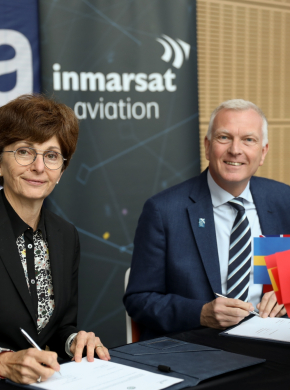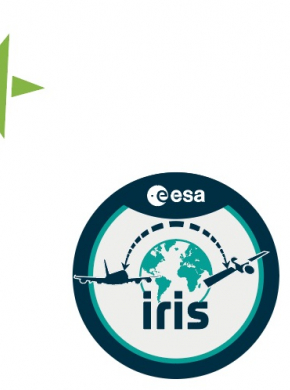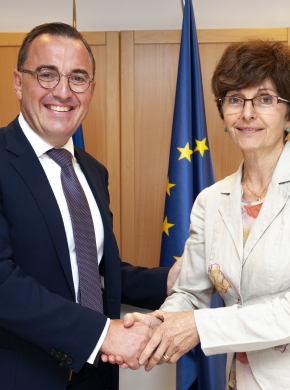With the anticipated increase in European traffic of more than 50% by 2040 and with the direct CO2 emissions from aviation accounting already for 5% of the EU-27’s total emissions in 2019, the aviation community is looking at how to decarbonise efficiently the European skies, with the target to meet climate neutrality by 2050. Among key pillars which include engine refinement and sustainable aviation fuels, EUROCONTROL has identified Air Traffic Management (ATM) modernisation as a relevant element which will bring optimised operations, shorter routes, and less fuel consumption, resulting in 5-10% CO2 emissions reductions. Iris SATCOM datalink programme, funded and promoted by the European Space Agency (ESA), will be a key enabler of ATM modernisation and will contribute significantly to the target emissions reduction, bringing also additional benefits for airlines and passengers.
The European Green Deal and ATM Masterplan goals
In the framework of the Green Deal, the EU is working on policies, technologies, and infrastructure innovations to achieve the target of climate neutrality by 2050, with an intermediate target of at least 55% net reduction in greenhouse gases by 2030. Data from the European Environmental Agency (EEA) indicate that in 2019 the overall aviation emissions in EU-27 accounted for at least 146 million Tonnes of CO2 equivalent gases: digitalisation and decarbonisation of air transport are therefore among the key objectives of the EC European Aviation Strategy, as highlighted in the Single European Sky ATM Research (SESAR) “ATM Master Plan”.
This is why the Single European Sky ATM Research (SESAR) has recognised the technological modernisation of ATM as a key enabler of a transformation towards the 4D Trajectory Based Operations (TBO – or initial 4D in the short term), which allows reduced flight separation and optimised flight corridors and routes. The result will be significant, including but not limited to:
• higher safety standards
• higher capacity to manage the increasing number of flights and reduce airport congestion
• Increased operational efficiency with a consequent less fuel burn
• reduced delays and flight time
• lower emissions of carbon dioxide per flight
• reduced cost per flight
In particular, SESAR has estimated that ATM modernisation can influence between 5 and 10% of aviation CO2 emissions in Europe.
Furthermore, Europe already has one of the world’s most congested airspace and EUROCONTROL has estimated that by 2040 the European air traffic will grow by more than 50%. In fact, despite the COVID 19 crisis, EU’s air traffic is expected to reach again the 2019 levels by the end of 2023, approaching the saturation of the capacity of the existing terrestrial infrastructure.
It is therefore vital that satellite technology is harnessed to contribute achieving the sustainability goals as well as to enhance the available capacity, efficiency, and safety of ATM.
What is Iris and how can it help?
Iris is a Data Link Service (DLS) satellite-based system funded and promoted by the European Space Agency. Iris uses the existing Inmarsat satellite infrastructure and is based on the Swift Broad Band-Safety (SBB) system, (already approved for safety services in oceanic areas) which through the Iris program will be extended for use in European continental airspace in line with ATS performances, complementing terrestrial VDL Mode-2.
Iris has been officially recognised as a key complementary component to the terrestrial datalinks to enable the ATM Masterplan benefits, bringing additional capacity, security, flexibility and resiliency.
Projected green benefits and savings of IRIS technology 2024-2040
While the capacity benefits have been assessed in Iris capacity study, we have estimated here the potential Iris green benefits. Assuming a realistic Iris equipage rate ramp-up, based on the Inmarsat business case, our analysis indicates that Iris benefits between 2024-2040 are likely to be as follows:
• Average CO2 savings in Europe of around 1.5-3 million tonnes/year
• Cumulative CO2 savings of 27-55 million tonnes CO2 (based on 5% and 10% assumptions, respectively)
From a financial point of view, these CO2 emissions savings are associated with a cumulative fuel saving of up to 18 million tonnes over the 2024-2040 timeframe, resulting in up to 3.5-7 B EUR savings (average 200-400 M Eur /year).
To put this in context, a saving of up to 55 million tonnes of CO2 as a result of Iris contribution would be the equivalent of the 2019 emissions of a country like Peru and would be higher than the annual emissions of Sweden or Norway.
Further benefits to be considered include for example optimised aircraft health monitoring and scheduled maintenance, reduced disruptions due to bad weather, optimised on-board inventory and other benefits that would sum up for a better service and reduced costs, both for the airlines and for passengers.
In summary, Iris SATCOM datalink is a key complementary component of the aviation future communication infrastructure, a key enabler of ATM modernisation. It will allow safer and more secure flights, alleviating air traffic congestion in the busiest European areas. Iris will also help reduce delays and the consequent excess fuel consumption, enhancing flight efficiency and resulting in lower CO2 emissions. The deployment scale of Iris, if appropriately supported by EU incentives, is a key enabler of a greener European aviation and will bring significant benefits to all airspace users.
Related Document
FEATURED OPPORTUNITIES
NEWS AND EVENTS
Italian airline signs up for space-enabled flights
Passengers flying on Italy’s national carrier ITA Airways will experience fewer flight delays and greener travel thanks to pilots being able to use satellites to route their planes.
The ESA-backed Iris for aviation system connects pilots…
ESA invites new proposals for EU Secure Connectivity programme
ESA has been a key partner of European industry around secure connectivity for more than 25 years, boosting innovation and competitiveness and facilitating the timely delivery of the most advanced SATCOM solutions worldwide through its…
easyJet signs up for space-enabled digital skies
Passengers on board commercial airline easyJet will speed to their destinations faster and greener, thanks to an ESA-backed initiative to digitalise the skies.
Iris system to digitalise airspace goes global
A space-enabled system to help clear congested skies while reducing carbon emissions is going global, following a deal signed today between satellite communications provider Inmarsat and ESA.
Satcom Maturity and Deployment
Satellite technologies are evolving and new modern and secured communications are being developed that offer new opportunities to meet current and emerging aviation requirements.
Iris takes a step closer to becoming a reality for air traffic management
A workshop on using a new satellite-based air-ground communication system for air traffic management took place at Brussels airport on 2 OctA workshop on using a new satellite-based air-ground communication system for air traffic management took…
Satellite-enabled air traffic control system takes to the skies
Air travel is set to become safer, swifter and more environmentally friendly thanks to the introduction of space-based technologies.
The Future in Aviation: Iris, a reality for Air Traffic Management
On Wednesday 2 October 2019, the European Space Agency and SESAR Deployment Manager are organising an event to update all ATM stakeholders on Iris, a new satellite-based air–ground communication system for Air Traffic Management.
Space tech poised to make air travel greener & more efficient
13 Mar 2019 - Several national air traffic control organisations have agreed to trial the commercial system, including those of Belgium, France, Germany, Italy, Luxembourg, the Netherlands, Portugal, Spain, Switzerland and the UK.
Iris System Takes first flight
17 July 2018 - Europe is one step closer to a safer, cleaner sky, as the Iris aviation satcom system completes its first set of test flights.
SESAR Deployment Manager and European Space Agency sign MoC
On 19 Jul 2019, SESAR Deployment Manager and the European Space Agency (ESA) have signed a Memorandum of Cooperation marking the start of the collaboration between both organisations to coordinate between the deployment of the satellite-based…
Preparing for air traffic control via satellite
20 Dec 2016 – Flight trials were recently undertaken by ESA and Inmarsat in the next stage of the ARTES Iris Precursor programme to deliver high-capacity secure digital data links via satellite.



